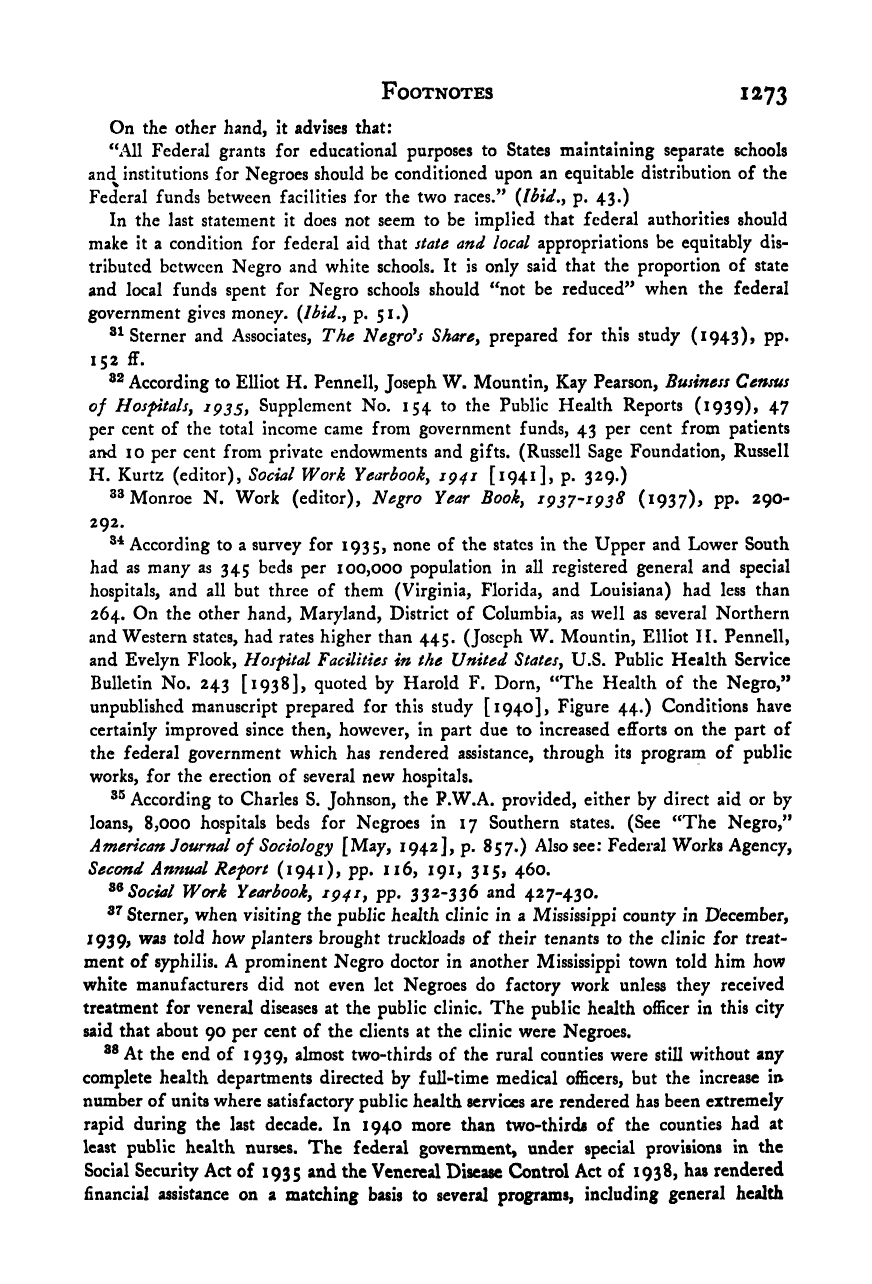Note: Gunnar Myrdal died in 1987, less than 70 years ago. Therefore, this work is protected by copyright, restricting your legal rights to reproduce it. However, you are welcome to view it on screen, as you do now. Read more about copyright.
Full resolution (TIFF) - On this page / på denna sida - Footnotes - Chapter 15

<< prev. page << föreg. sida << >> nästa sida >> next page >>
Below is the raw OCR text
from the above scanned image.
Do you see an error? Proofread the page now!
Här nedan syns maskintolkade texten från faksimilbilden ovan.
Ser du något fel? Korrekturläs sidan nu!
This page has never been proofread. / Denna sida har aldrig korrekturlästs.
Footnotes 1273
On the other hand, it advises that:
“All Federal grants for educational purposes to States maintaining separate schools
and institutions for Negroes should be conditioned upon an equitable distribution of the
Federal funds between facilities for the two races/’ {lbid,y p. 43.)
In the last statement it does not seem to be implied that federal authorities should
make it a condition for federal aid that state and local appropriations be equitably dis-
tributed between Negro and white schools. It is only said that the proportion of state
and local funds spent for Negro schools should “not be reduced” when the federal
government gives money. {Ibid., p. 51.)
Sterner and Associates, The Negroes Sharey prepared for this study (1943), pp.
152 ff.
According to Elliot H. Pennell, Joseph W. Mountin, Kay Pearson, Business Census
of Hosfitalsy ig35y Supplement No. 154 to the Public Health Reports (1939), 47
per cent of the total income came from government funds, 43 per cent from patients
aiKl 10 per cent from private endowments and gifts. (Russell Sage Foundation, Russell
H. Kurtz (editor), Social Work Yearbooky 1941 [1941], p. 329.)
Monroe N. Work (editor), Negro Year Booky 1937-1938 (i937)> pp. 290-
292.
According to a survey for 1935, none of the states in the Upper and Lower South
had as many as 345 beds per 100,000 population in all registered general and special
hospitals, and all but three of them (Virginia, Florida, and Louisiana) had less than
264. On the other hand, Maryland, District of Columbia, as well as several Northern
and Western states, had rates higher than 445. (Joseph W. Mountin, Elliot II. Pennell,
and Evelyn Flook, Hosfital Facilities in the United Statesy U.S. Public Health Service
Bulletin No. 243 [1938], quoted by Harold F. Dorn, “The Health of the Negro,”
unpublished manuscript prepared for this study [1940], Figure 44.) Conditions have
certainly improved since then, however, in part due to increased efforts on the part of
the federal government which has rendered assistance, through its program of public
works, for the erection of several new hospitals.
According to Charles S. Johnson, the P.W.A. provided, either by direct aid or by
loans, 8,000 hospitals beds for Negroes in 17 Southern states. (See “The Negro,”
American Journal of Sociology [May, 1942], p. 857.) Also see; Federal Works Agency,
Second Annual Refort (1941), pp. 116, 191, 315, 460.
Social Work Yearbooky 1941y pp. 332-336 and 427-430.
Sterner, when visiting the public health clinic in a Mississippi county in December,
1959, was told how planters brought truckloads of their tenants to the clinic for treat-
ment of syphilis. A prominent Negro doctor in another Mississippi town told him how
white manufacturers did not even let Negroes do factory work unless they received
treatment for veneral diseases at the public clinic. The public health officer in this city
said that about 90 per cent of the clients at the clinic were Negroes.
At the end of 1939, almost two-thirds of the rural counties were still without any
complete health departments directed by full-time medical officers, but the increase in
number of units where satisfactory public health services are rendered has been extremely
rapid during the last decade. In 1940 more than two-thirds of the counties had at
least public health nurses. The federal government, under special provisions in the
Social Security Act of 1935 and the Venereal Disease Control Act of 1938, has rendered
financial assistance on a matching basis to several programs, including general health
<< prev. page << föreg. sida << >> nästa sida >> next page >>